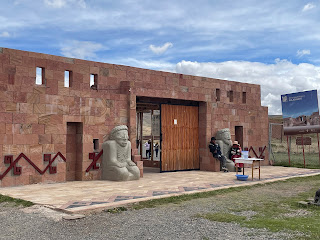Pilots call it "density altitude." Hot air is thinner and lighter than cooler air (that's what makes hot air balloons go up). As the day heats up, the air gets thinner, whether one is at sea level or two miles up. When trying to take off from an airport at 13,300 feet elevation, the air is already pretty thin, and heating it up -- even just a little bit -- can make a big difference in how quickly a plane can get off the ground. True, big jet cruise in the range of 30,000 to 40,000 feet. But cruising is much less of an issue than getting off the ground in the first place. If the effective altitude is too high, the plane can run out of runway before getting airborne.
That's why big jets only schedule international flights from La Paz, Bolivia -- the highest international airport in the world -- at the coolest part of the day. And it's why we had to leave our La Paz hotel in the middle of the night -- 12:30 a.m. -- to get to the airport for our 3:30 a.m. flight to Bogota. And that's why we are once again sleep-deprived zombies today.
We arrived in Bogota at about 6 a.m. local time, were met by our new tour leader, Alejo Garcia, and were driven to our hotel in morning rush hour traffic. Bogota is visibly more prosperous than La Paz. It's a modern city that looks much more like southern Europe than a tropical developing country. Our hotel is in a very nice area just a little over a mile east of the central business district. There are lots of banks, securities companies, and other financial institutions nearby. Businesspeople on the streets are very fashionably dressed.
It was much too early to get into our hotel rooms, so Alejo took us on a walking tour of the neighborhood. We have a nice little park nearby. There are tons of very nice restaurants in the area -- mostly ethnic restaurants. Alejo explained that Colombians don't like to go out to eat food they could make for themselves at home, so there are almost no restaurants here that serve traditional Colombian food.
Coffee is a big deal in Colombia. There is a Starbucks nearby, of course. But Colombians generally prefer one of their many local coffeeshops. Alejo took us to one. Mary and I each had a very good cappuccino. Others ordered lattes or plain black coffee. A few ordered pan de bono, a traditional Colombian cheese bread that is popular with morning coffee here.
Alejo took us by a local bank where we could all use the ATM to get Colombian Pesos. Right now, there are 4,600 Pesos to the U.S. dollar! A 50,000 Peso note is worth about $11 U.S. And folks in the U.S. think that inflation is bad there! The inflation rate is about 13% here, and Biden has nothing to do with it.
While waiting for the ATM, we were approached by a young woman in a long skirt and bonnet. She was a Mennonite teenager from Pennsylvania who heard us speaking English. Her family has been here about three years on some sort of religious project, but she was feeling a little homesick for American English.
We finally got a room about 10 a.m. It felt as if it had been a long day already, so we went down for naps. Then we showered and began a new day. It started with lunch at a Peruvian seafood restaurant a couple blocks for the hotel. The meal was excellent, a wonderful bargain, and we were able to get through the experience without total embarrassment, despite our very limited Spanish language skills.
Next, we walked about 15 minutes to a shopping mall that we had been told about. It looked like pretty much any high-end shopping mall anywhere. Mary wanted to look in one small shop, and before I could even greet the clerk with my very best buenas tardes, she welcomed us in perfect, unaccented English. I laughed and asked, "Do we really look that American?" She laughed and said, "Just a little bit." As much as we try to blend in, we stand out in the crowd.
Still not fully recovered from a night with little sleep, we returned to the hotel for a bit of rest. We hit one of the several local brewpubs in the neighborhood this evening. Early. Then we'll try for a good night's sleep. We meet the rest of the group and begin the tour tomorrow morning.


















































